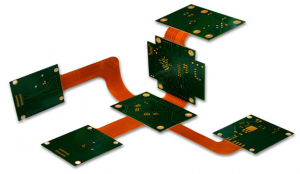Solder Masks in Rigid-Flex PCB Fabrication
Printed circuit board fabrication involves many processes to ensure the quality of the finished product. One of the most important is applying a solder mask to the copper traces on a PCB. A solder mask protects the traces from oxidation and provides an unobtrusive barrier between conductive surfaces during assembly. It also prevents unintended connections between adjacent pads, known as solder bridges. Depending on the design and application of a PCB, it may be best to use either a flexible or a rigid solder mask.
To apply the solder mask, manufacturers use different screen printing techniques. The most common is using dry film photoimageable solder resist. This is ideal for high-density wire boards because it does not flood the through-holes with copper, allowing components to be soldered easily. However, if the PCB has complex surface topography, a liquid-based mask may be more suitable.

When choosing a mask material, it is important to consider its thickness and adhesion. A thick mask will be more difficult to clean, which can impact the manufacturing process. Likewise, a thin mask will not be durable enough to stand up to the stresses of reflow soldering and manual handling. In addition, a thin mask may not adhere to the rigid flex pcb fabrication, which can lead to solder mask bridging or even delamination.
The Role of Solder Masks in Rigid-Flex PCB Fabrication
It is also crucial to design the solder mask openings properly. The dimensions must be accurate, as misalignments can cause them to overlap and expose the copper pads. This can result in the pads being incorrectly positioned on the PCB, or they might not be able to connect to other copper pads during reflow soldering. In both cases, the resulting connections are not as reliable.
In addition, the PCB fabrication process requires the mask to be able to hold its shape after exposure to UV light and curing. This is called thixotropic behavior, and it helps to avoid the formation of solder bridges by allowing the ink to maintain its shape when the board is heated during reflow soldering.
The solder mask is a critical component of the rigid-flex PCB, and its quality can have a major impact on the reliability of the finished product. Proper planning and preparation will help to minimize any issues with the application of the solder mask, making the entire fabrication process much easier and more efficient.
When designing a PCB, it is essential to consider the implications of the solder mask clearances and thickness. These parameters will determine the accuracy and manufacturability of the PCB. By working closely with the manufacturer, designers can optimize their PCBs for performance and reliability while ensuring that the product meets the necessary quality standards. For example, it is vital to ensure that the solder mask openings are accurately aligned with the copper pad sizes and manufacturing tolerances. Also, it is crucial to provide adequate solder mask relief for test points, fiducial marks, and other functional requirements. Achieving these goals will allow the designer to maximize the functionality of their final product while minimizing production costs.

